A crossing for oxen, they
called it. Good enough, right? Who doesn’t like oxen? They go nuuo. Watch them
mooch across the river. Touch them, if you really want. Build your civilisation
around all the stuff they do for you. Was that not enough?
Apparently not, because then they
just had to go and do this.
 |
| “I have an idea, let’s pack
our settlement with as many limestone |
 |
| So they did, and now everyone thinks they’re special. |
So rose the dreaming spires,
as they were so irritatingly immortalised in the poetry of Matthew Arnold, and
in their image the oxen-ford – one of so many – became the den of one of the oldest
and most prestigious institutions of all humankind. To this day the crackling
magnetism of its erudite pinnacles strikes awe into throngs of aspiring
participants and visitors from all the inhabited corners of this world...
...for most of whom its name, with its scholarly romance, is all but synonymous with that of the
settlement which hosts it.
Here, then, is Oxford: principal city
– only city – of the upper Thames, and capital both of its wealthy shire
and of the English literary imagination.
But we aren’t here for the romance.
This critical expedition up the Thames (‘or Isis’, as they call it here) has proceeded upon the principle
that the more highly a place’s power pierces the sky, the heavier the anvil of
scrutiny onto which its ear must be brought down. And here, at the very peak of
the procession of the Privilege Forts of the middle Thames, we confront – just
look at it – the most practised and proficient sky-shredders of all.
What is Oxford, really? Is there not,
beneath the glamour and fancy masonry, a Thames town like any other? An Oxford
of wars and riots, of massacres and plagues, of industrial hope and ruination,
of brutal exclusion and injustice? The people of this city would be the first
to tell you that the university is not all that Oxford is, and has in fact been
an almighty pain in the arse for its mere mortal populace at times. And as for
that university, for all its polished dialects and lengthy bibliographies, should
we not expect that it is but one more creation of the English, with all the
dreadful tendencies they have displayed when they get their hands on power?
 |
| The river downstream near Abingdon. A world away from the spires, yet ever in their shadow. |
With its enormous weight in books,
films and other popular media, Oxford projects the expectation of its atmosphere
of enchantment across its surrounding countryside. But the length of river that
links it to Abingdon, though never far on the map from the grand city or its
satellites, feels like the remotest reach so far on this journey. Perhaps its
magic has deteriorated along with its country? Or was it always more illusion
than reality? Either way it is time to traverse it, and so complete the middle Thames passage.
 |
| Upstream from Abingdon Bridge, the start of today’s section, on a fog-filled late summer’s morning. At right is the Nag’s Head pub on its namesake river island. |
Start: Abingdon Bridge (nearest station:
miles away, take the bus to Stratton Way from Oxford or Didcot Parkway instead)
End: Osney Bridge (nearest station: Oxford)
Length: 15.2km/9.5 miles
Location: Oxfordshire – South Oxfordshire,
Vale of White Horse, City of Oxford
Topics: Abingdon outskirts, Nuneham
Courtenay (with Lewis Carroll, and the forced removal of an entire village),
Radley (with Radley College), Sandford-on-Thames (with the ‘Sandford Lasher’),
Oxford suburbs, Oxford – City and University
Abingdon outskirts
The lay of Abingdon’s surroundings was
shaped long ago by its monastery. Across the two-part Abingdon Bridge
the island of Andersey, now the town’s recreational green space, was formed by
the ‘Swift Ditch’ which the monks cut through this corner a millennium ago.
 |
| Then the bush packs in, a preliminary taste of green density to come. |
 |
| A few thoughtfully-positioned spiderwebs have revived this withered bush as a natural art installation. |
 |
| And here’s the food court, doing hearty custom this morning. |
Just upstream of the town sits Abingdon
Lock. At first glance a 1790 Thames Navigation Commission job like many of
the others, this lock is in fact a creature of the long hydropolitical story of this
bend. For most of
the preceding centuries the Abbey’s ‘Swift Ditch’ had functioned as the main
channel for river traffic. But with the coming of industrial times, Abingdon’s
mercantile interests, likely eyeing the imminent arrival of the Wilts and Berks
Canal, managed to revert the main route to this natural channel and got this
lock constructed as part of that process.
 |
| Abingdon Lock. |
 |
| The weir is thought to descend from one the monks built in the tenth century. Walkers can cross it to the north bank, as the south has impassably steep woods ahead. |
 |
| A more exotic breed of cattle than those more regularly encountered on these stretches. |
The north bank now provides an escape
from Abingdon through the Barton Fields. This former infrastructural
land has been converted to a rich little nature reserve, designated in 2003 and
managed by local volunteers to promote biodiversity.
This being a nature reserve, it’s
worth keeping an eye out for early morning friends.
 |
| Today was one of the last blasts of summer, with the cooling nights coating the plant life in dew. |
The upper entrance to the ‘Swift
Ditch’ marks the effective limit of Abingdon’s control of the river, and the
entry in earnest to Oxford’s inner envelope.
 |
| Provoked past its patience by the manifold misdeeds of this society, the grass here seems to have risen up and devoured whole the users of this picnic site. No-one has dared go near it since. |
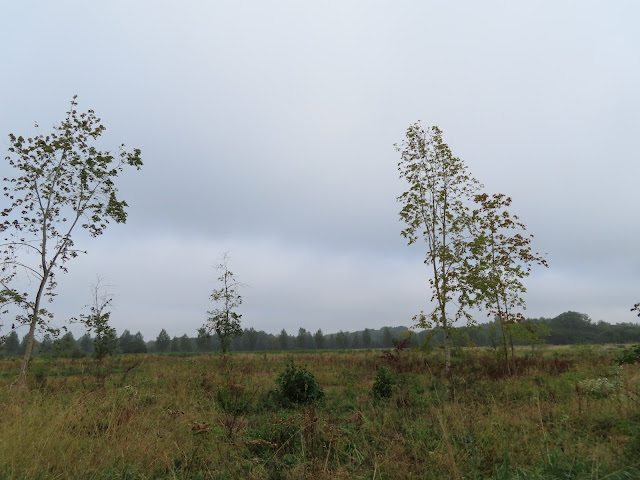 |
| Out of sight beyond the northern fields are more gravel pits, abandoned decades ago and since flooded to form the Radley Lakes. Originally numbering over a dozen and spreading all the way up the banks ahead, about half were obliterated when the electrical authorities and corporations began dumping waste ash from Didcot Power Station into them. This provoked a frantic community campaign, which in the 2000s managed to stop the destruction and preserve what was left of the lakes as a recreational space and wildlife reserve. |
 |
| Is the water magic because of Oxford? Does drinking it make you more knowledgeable? Want to try it? (Hint: don’t try it.) |
This then is the Oxford Green Belt:
a doughnut of land, some five miles in radius, where since 1975 planning and
development have been heavily constrained by the local authorities to limit
Oxford’s urban sprawl.
In an English context Green Belts
became an established notion in the twentieth century, championed especially by
Labour Party administrations against the harms of rampant urbanisation and now
in place around some dozen towns and cities. They are resented by the priests
of the free market, whose go-to argument seems to be that Green Belts reduce
space for building houses, thus pushing up house prices and contributing to the
English housing crisis (a far from theoretical problem in this particular
region). In fact Green Belts are a red (or perhaps green) herring on this matter.
The housing crisis has less to do with land scarcity and more to do with the
English class system – specifically, the policy-driven disappearance of
affordable social housing, and a housing sector configured not for those who
need somewhere to live but rather for bankers, housing speculators and rampant
landlordism.
 |
| White and purple daisies like these are in abundance up this riverbank. They’re not to blame for this country’s homelessness disaster. |
 |
| To the south, the bush has started to gobble up this forgotten agricultural concern. |
 |
| More earthworks to the south. A tradition stretching back thousands of years in this region was added to by these more recent works to build the Culham off-road motorcycle (‘motocross’) racetrack. This prestigious course in the motocross world is currently a battleground in the Green Belt war; property developers are hungering to overwhelm it with an estate of over 3,000 new (and no doubt unaffordable) houses that would be several times larger than most of the surrounding villages. |
Here the Nuneham Railway Bridge –
colloquially the Black Bridge – brings the Great Western Railway’s
Oxford branch back across the river, with which it now runs in parallel the
rest of the way to Oxford.
 |
| The original Nuneham Bridge was an 1844 timber Brunel design, but was replaced in iron the following decade. The present steel bridge replaced that in turn in 1929. |
 |
| As if to show arrivals that they are not to be messed with, the Oxford sorcerers have captured some superhero and imprisoned his soul in the brickwork beneath the bridge. |
Nuneham Courtenay
The bridge gets its name from a
village which ought to be just ahead on the east bank. Nuneham derives
from New Ham, simply “new farmstead/settlement, and its riverbanks offer
the prettiest hints so far of the postulated Oxford enchantment.
 |
| The thick tree cover of Lock Wood packs the south bank slope here. |
 |
| Evidence of a methodical approach. Much of this land isn’t so much left green as kept green. |
 |
| There we go – a tunnel to another world. Watch out for suspicious rabbits. |
Of all the stories soaked in these
woods and reeds, none is so redolent as the excursions of Oxford mathematician and
cleric Charles Lutwidge Dodgson (1832-1898) – better known as Lewis Carroll,
author of Alice’s Adventures in Wonderland (1865) and Through the
Looking-Glass (1871). Weaving together extraordinary otherworlds and logical
puzzles and paradoxes with a comically absurd cast of characters (anthropomorphic
animals, political caricatures, megalomaniacal playing cards and chess pieces
all included) along with some quite renowned body-altering food, the Alice
stories have been among the most phenomenally influential works in all of
English literature. Accessibly presented yet deeply profound, their tropes so trouble
the margins between reality and imagination that they have not only seeded their
way into cultural consciousnesses worldwide (Alice is enormous in Japan
for instance) but also spawned an entire field of study whose devotees, known
as Carrollians, have dedicated breathtaking time and ink to unpacking
the mysteries of these texts and their oftentimes bewildering author.
What is not in doubt is how
fundamentally the Oxford Thames (‘or Isis’, they’ll remind us) provided the
seedbed for what Carroll nurtured forth. The people, buildings and ways of life
that surrounded him at Oxford University’s Christ Church College inspired many
of the characters, structures and motifs of these tales, whose main content he
appears to have come up with spontaneously during boat trips with friends up or
down the river.
Famously friends for Carroll
often meant little girls, whose company he preferred and with whom his
fascination regularly comes through in his writing. Such a character would
likely not have survived the baying mobs of today, who are inclined to scream
pedophile at non-conforming individuals, harmless artistic subcultures, or otherised groups with marginalised sexualities or darker skin pigmentations, but have little to say – or rather, blame the victims – when actual
sexual abuse is committed, within their structurally abusive society, by established power such as
celebrities, rich businessmen, priests, sports coaches, police officers, mainstream
authoritarian parents, or certain members of the royal family.
In fact no evidence has been found of
any erotic dimension to Carroll’s much-studied interest in young girls. His sexuality is
rather one of his many eccentric mysteries which, along with those of his
mental health and attitude to religion, invite perhaps more pertinent questions
into how far his Oxford privilege made a life of such idiosyncrasy supportable
at a time when the judgemental and punitive Victorian norms of his country – certainly abusive to children in the extreme – wrecked
so many misfits who lacked his class protection.
The main inspiration for Alice
is thought to have been one of the girls in question: Alice Liddell, also of an
Oxford University family. It was to her and her sisters during one such boat
trip up to Godstow that Carroll came up with the earliest version of what, on them
enjoying his telling and asking him to write it down, eventually grew into the
manuscript for Wonderland. Frequently his rowing parties also came down
here to Nuneham, whose setting is thought to have heavily influenced its Looking-Glass
sequel.
 |
| Alone in a riverside clearing – but not looking particularly put out by its solitude – is what appears to have been Radley College’s old boathouse, now re-done into some unaffordable private mansion. |
So far so enchanted then? Let’s ruin
that.
The question all this raises is where
this village of Nuneham, which is supposed to be right there on the east riverbank,
actually went. Like Sutton Courtenay downstream it got the name of the de
Courtenay family of Norman nobility attached to it. In this case it happened
later, around the fourteenth century, as part of a merry-go-round of titled
big-named families who got hold of the manor when their predecessors died
without heirs or fell from political favour.
This revolving door spun on till Nuneham
fell into the hands of the Harcourt family (another Norman hangover, now
extinct). More specifically it was bought by their first earl, the diplomat
Simon Harcourt, and at his will something extremely English happened.
 |
| Where Nuneham village once stood, there is now this opulent Palladian villa in 470 hectares of landscaped pleasure-gardens. |
Simon Harcourt decided that he wanted
a residence in Nuneham with lavish gardens, a sweeping view of the river, and
all other such luxuries as befitted his noble caste. The only problem of course
was Nuneham itself. The village, and the people living in it, were in the way. And
so he had it demolished – manor house, cottages, church, the lot – and rebuilt
a mile and a half to the east to make way for Nuneham House, his new riverside
villa, with a vast park that would later receive the attentions of Lancelot
‘Capability’ Brown, England’s landscape-artist-in-chief.
As for the impact on the people who
lived there, let alone the question of their consent – well, these of course
are not recorded. This was a period in which the broader Enclosure movement to
which this act belonged was laying waste to the rural communities of England,
who for the whim and profit of rich landowners, were thrown off their
traditional land into poverty, starvation, and a growing regime of laws, courts
and sadistically violent punishments to stop them ever getting it back. Quite
typically, since the winners of this process were the ones who wrote the
history, all readily available information today on what happened here seems to
be about how spectacular Citizen Harcourt’s amazing new villa was, with not one
word on the feelings or fates of the villagers it displaced.
One of the most cutting contemporary critics
of this decimation of the English peasantry – its customs, folklore and knowledge
as well as its livelihoods and bodies – was the Irish poet Oliver Goldsmith.
His long poem The Deserted Village (1770) lamented the death of a hamlet
named ‘Auburn’: its buildings dilapidated, its fields seized for the villas and
parks of the ‘man of wealth and pride’, its inhabitants lost to the cruelties
and corruptions of the cities or to overseas emigration. ‘Auburn’ is fictional,
but Goldsmith is known to have personally witnessed and condemned the
destruction of a certain village near London to make way for a landscaped villa.
This was almost certainly Nuneham Courtenay, which so closely resembled the
poem’s details that it is thought to have been its main inspiration.
Alas then, this landscape is not some
magically-enriched Oxford romance after all, but a direct result of this most
consequential yet still so poorly-acknowledged phenomenon of systemic mass
abuse in English history. Needless to say, its main current then – the
destruction of the vulnerable for the arrogance and pleasure of the privileged
– is still the main current now.
Radley
Meanwhile here on the western bank
the fields nest a better-known settlement. Radley appears to derive from
the Anglo-Saxon read leah, for ‘red clearing’, on a site settled on and
off for thousands of years.
The main village is a kilometre and a
half inland, clustered between its thirteenth-century church and its train
station. Closer to the river it has also sprouted the satellite hamlet of Lower
Radley, from where a road connects to this boating facility.
 |
| Radley College Boathouse – the base for that school’s river training. |
 |
| This is not a small installation. |
The school in question is what
elevates Radley’s name, for Radley College is no less than another piece
of this country’s infamously influential ‘public school’ tradition which we
took apart at length in Eton. Founded in 1847 as part of a wave of Victorian
school-building, Radley College’s 320-hectare compound is about as large as the
village itself. Soon it even proved it had such clout as to get Radley its
own railway station, built specially for its pupils in the 1870s.
Recalling that a militaristic
dedication to sports – especially rowing – is at the core of these schools’
ethos, one might imagine that the river here gets quite rowdy when the students
of Radley descend on these facilities along with their megaphone-toting
coach-totalitarians. Yet for now, they aren’t here, and beside the occasional
walker the village of Radley seems to make no further imprint on this
landscape.
 |
| Meadows, woods and farm fields cover the inland side, shielding the village from view. |
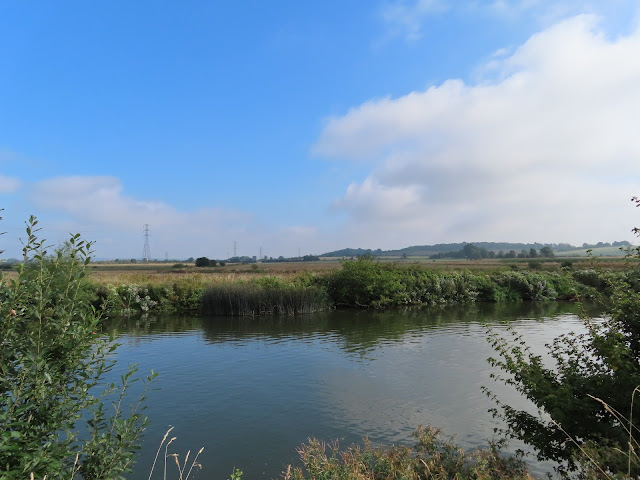 |
| The east is much the same: a wide spread of farms with little in the way of settlement. |
 |
| It’s pretty, that much can be conceded. |
 |
| Look carefully and you might spot the occasional native hunter-gatherer attempting to catch fish. |
And then, after another kilometre or
two in this vein, signs of human activity trickle back in, for ahead is the outer
tip of Oxford’s urban constellation.
 |
| Sightings of large rural creatures are less common on this section than those preceding it. |
Sandford-on-Thames
The sandy ford – Sandford
– has spent most of its life since the Domesday survey as a tiny agricultural
river hamlet, although it did host the Knights Templar for a time. Its main activity
centred on a mill next to where Sandford Lock is now, whose labour-intensive work
would likely have employed most of the one or two hundred people who lived
here.
 |
| Sandford Lock is the deepest of all the Thames’s pound locks and also one of its oldest, built as far back as 1631 by the Oxford-Burcot Commission. It links Sandford on the east bank with a couple of elongated river islands, of which the northern is known for its shape as ‘Fiddler’s Elbow’. |
Major redevelopment in the last
century has since pushed Sandford’s population to over one thousand and joined
it to the very tip of the Oxford conurbation. Socio-economically it has been
integrated closer still. Its neighbourhood now includes the hulking Oxford
Science Park, built in 1991, owned by the university’s Magdalen College and
host to over sixty science and technology companies; and the Kassam Stadium,
opened in 2001 as the base for Oxford United Football Club and named for its
dodgy billionaire owner.
 |
| The lock islands are a popular little green space for the locals’ recreations. |
 |
| This one cares a great deal. The eyebrows and moustache make it apparent. |
The Sandford islands’ west channel
harbours a dark secret. It is there that they built the weir for Sandford Lock,
known as Lasher’s Weir. It created a pool which harbours deceptively
powerful sub-surface currents, and by the late nineteenth century these were dragging
down and drowning so many boaters and swimmers as to raise the Sandford
Lasher, as it became known, to national infamy. Warnings about it were
soon cropping up through the literature of the time, with Thomas Hughes’s Tom
Brown series, Charles Dickens Jr.’s Dictionary of the Thames, and
Jerome K. Jerome’s Three Men in a Boat all referring to its dangers.
Many of the Lasher’s victims were
Oxford students, whose names are now inscribed on a memorial obelisk atop the
weir. Perhaps the most famous of these casualties was a certain Michael
Llewelyn Davies – ward of novelist J. M. Barrie, the author of Peter Pan.
Davies was the inspiration for that story’s main character, the ‘boy who
wouldn’t grow up’, which only added a further tragic twist to his drowning here
in 1921, aged twenty, together with his close friend and fellow Oxford student
Rupert Buxton.
Yet this wouldn’t be England without
a further, more socially abusive twist to the tale. On their recovery the two
young friends’ bodies were found clasped together, such that the inquest concluded
that Davies had got into difficulties and Buxton had drowned trying to rescue
him. But speculation by Davies’s brothers, friends, and Barrie himself has ever
since kept open a different possibility: that the two friends were romantically
and/or sexually close and drowned here in a suicide pact. Though impossible now
to prove, there is no doubt as to this country’s malicious hostility to
same-sex affection, then and in many quarters now; not least when its destruction of Oscar Wilde would have been fresh in memory, and
less still when the (likewise persisting) violent masculinism from which that
hostility springs, with its hatred for Davies’s softer Peter Pan model of
manhood, had just fed a million of its people, mostly young men, into the blood-spattered
meat-grinders of World War I.
Were Davies and Buxton murdered not
by the Sandford Lasher, then, but by an English atmosphere of alienation and
prejudice? We cannot know for sure, but the girders of the Oxford Wonderland
look brittler for every step we take.
 |
| This stream cuts between the islands to the Sandford Lasher on the west channel. The memorial to the Lasher’s victims is no longer accessible: the local community, perhaps with an eye to the place’s dark reputation, have recently installed the ‘Sandford Hydro’ hydroelectric plant in hopes of transforming the weir into a hearty source of clean energy. Its three big blue Archimedes Screws – a pump device whose design goes back to ancient Egypt – stand out clearly on satellite maps. |
 |
| This most vocal squadron noisily circles the skies above the ‘Fiddler’s Elbow’. |
 |
| This bridge connects the island’s north tip with the western bank, where the towpath resumes its approach to Oxford. |
 |
| The rather specific choice of languages on this sign might bear consideration. |
Oxford suburbs
Likely in the same spirit as the
Oxford Green Belt, the city’s southward expansion has preserved a leafy
corridor for the river itself. It now threads a way into the heart of Oxford
between a cluster of villages absorbed as residential suburbs.
To the west, Kennington
stretches north to south along the old Abingdon Road. Like Sandford it has spent
most of its days as a tiny agricultural hamlet, most likely growing up in service
to the Abingdon monastery. It submerged in the records after the Abbey’s
destruction, but eventually resurfaced with its life squarely oriented towards
Oxford. Its present-day shape and identity is largely a product of the last
hundred years.
 |
| Mysterious stone remnants sit about the Kennington riverbank. What might this have been? |
 |
| And here the towpath turns to tarmac, signalling its entry to the Thames’s highest city. |
To the east rises a small plateau
known as Rose Hill, a key patch of flood-safe high ground on Oxford’s
shoulder which for the last thousand years has been controlled by the manor
village of Iffley. The origin of that name is unclear – some kind of
clearing (ley) – but over the centuries the power in this village,
especially over its highly productive mill, transitioned from the Norman
nobility (specifically the St. Remy family) to numerous Oxford concerns.
Like Kennington, Iffley has done its
best to preserve its independent sense of village life. Nonetheless by the
eighteenth century it was metamorphosing into a residential appendage of Oxford,
all the more so following the industrialisation of the city’s east side – most
of all the car factories of Cowley – from the 1920s on. With the arrival both
of middle-class urban escapees (typically to its nicer suburban housing), as
well as immigrant factory workers and poorer people cleared from Oxford’s slums
(typically to council estates like that which now occupies the top of Rose
Hill), Iffley has transformed dramatically and now stands on that difficult
margin between urban and rural, wealthy and downtrodden, dream and nightmare.
 |
| Another member of the local angry berry family, this species appears to have got over its internal quarrels and developed apertures to fire plasma at passers-by instead. |
 |
| Meanwhile Oxford appears under invasion by an independent crocodile army from this direction. The attackers have already seized this entrance and plastered their colours over its walls. |
Iffley has its own lock, another
early 1630s Oxford-Burcot Commission piece (although frequently repaired and
upgraded, most recently in 1927). The final lock on the approach to Oxford, it
exhibits a few unique quirks that bind it to the life of that city.
 |
| Somewhere in here there’s a metaphor for the English’s struggles at saving their history. |
 |
| Oxford’s rigorous wisdom tradition is here on glorious display. |
 |
| Iffley Lock, with its weir stream at right. Iffley’s mighty mill, prolific in both woollen cloth and a range of agricultural foodstuffs, stood about this site till it went down in a fire in 1908. |
 |
| Unique among the locks on this journey, Iffley’s has installed these rollers on a side-stream for the easy passage of punts. The ducks here come up to you expecting food. |
Here then is the point of no return. To
pass through this lock is to commit to braving the terrors of the university
city, whose fiercest statements of outward force-projection – its boathouses –
stamp their claim on the riverbanks ahead.
 |
| The Isis Farmhouse is a nineteenth-century pub, seemingly once an actual farmhouse, whose advantageous riverside situation can only be reached on foot, bike or boat. |
 |
| Scary at first, but a false alarm: this is just an ordinary public boat hire, not an outpost of the University navy. |
 |
| Typically of this country, the one place on the middle Thames actually named for cattle is the one where we hardly encounter any. |
 |
| In the distance here is Donnington Bridge, one of the Oxford Thames’s few available vehicle crossings. Its position makes it a popular site to watch the University’s rowing commotions. |
The pair of suburbs on either side
here, Donnington to the east and New Hinksey to the west, are
largely nineteenth- and/or twentieth-century housing developments. These too
keep their watchful distance from the river, because here, now, we are in rower
territory.
 |
| Territory which expands with every passing day. |
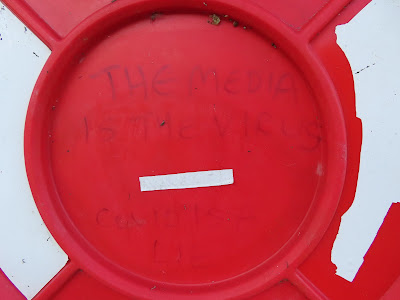 |
| Once more the university city’s intellectual pedigree is proudly on show. ‘THE MEDIA IS THE VIRUS’ and ‘COVID IS A LIE’ have here been graffitied onto this emergency life-ring holder. |
 |
| At left are another couple of backwaters. These ones trickle off through the Longbridges nature reserve before rejoining the river via the Hinksey Stream. |
The river widens at this kink, known
in Oxford rowing parlance as The Gut. This is likely to indicate that in
rowing culture this is considered a reasonable place to eat passers-by.
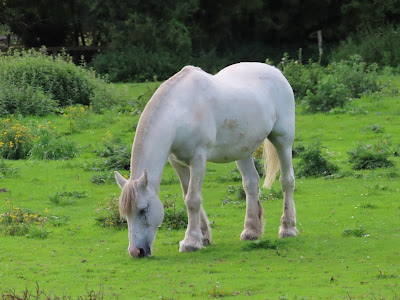 |
| The unified Oxford University Boat Club, which coordinates the colleges when they come together to fight their Cambridge rivals in the annual Boat Race, also stood here till it burnt down in 1999 with the devastating loss of its historical archives. They have since built a new headquarters downstream of Wallingford. |
The River Cherwell, Oxford’s
defining tributary, arrives at the Thames in two channels that draw the sides
of this fearsome nest of oars. Journeying far to get here from
the hills of Northampton province, it feeds the larger river the northernmost
water in its drainage basin.
The serene glide of the Cherwell is
at the core of the university’s cultural identity, hosting the majority of its
summer leisure-punting and lending its name to its principal student
newspaper. That said, its name origin appears an utter mystery, and its true
character is said to be ferociously bad-tempered.
 |
| Take its double confluence for instance. This lower one is artificial. Known as the New Cut, it was dug out to relieve the Cherwell in 1884... |
 |
| Another fine offering from England’s most hallowed centre of scholarship. |
One final suburb perches over
Oxford’s front door. The Abingdon Road, which here enters the city, historically
came in over a Norman-engineered stone causeway, possibly of earlier Saxon
origin. Still buried somewhere beneath the present-day road, the memory of this
‘Great Bridge’ survives in the south bank suburb’s Norman French name of Grandpont.
In Grandpont’s case it was the coming
of the railways in 1844 that set off its growth into a suburb. And it is here
that we arrive, at last, in Oxford proper: for this, it is said, is the site of
the original oxen ford, and hence, if the name is accurate, this city’s
birthplace.
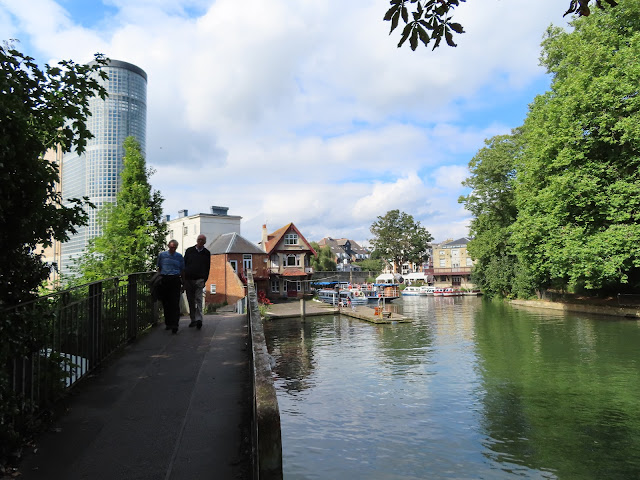 |
| At Oxford’s threshold, the river splits round a small island whose buildings include a restaurant and steam boat hire service. There’s no going back now. |
Here, then,
are the spires, the boss stage, the Privilege Fort of Privilege Forts, the
grandest imaginative exercise of all to conclude the valley of
imagination that is the central Thames.
Oxford – the City
Thus far it is the fabled University
of Oxford which has done most to advertise its city unto the river. Are we to
suppose, then, that the water now leads us straight to the feet of its glistening
towers of power?
 |
| Actually, no. In fact the Thames curves off west, away from the spires and round the city’s backside. |
Suddenly the University might as well
not exist. The river winds unglamorous through a post-industrial green sleeve amidst
backstage bridges and graffiti-strewn pieces of yesterday. Breaking what’s left
of the reverie, they sink us back to the question of reality. Is there, then, an
actual Oxford – that is, a settlement – behind, or beneath, the soaring
diorama?
 |
| More evidence of two different Oxfords. Can the city which did so much to develop the AstraZeneca COVID-19 vaccine be the same city that exhorts you to ‘TAKE YOUR FACE NAPPIES OFF’? |
Oxford began as they all did: with
the river. Here, sandwiched in the centre of the broad clay vale between the
Cotswolds and the chalk, its water is bottlenecked through a
cluster of low hills and breaks into a tangled web of backwaters and
side-channels. These, along with its aggressive rendezvous with the Cherwell,
would have made these marshes a flood-prone deterrent to any aspiring settlers.
Perhaps this explain why, though plenty of evidence for ancient activity has
been dug up here – Neolithic arrowheads, Bronze Age barrows, Roman pottery
kilns – this seems to have been generally rejected as a site for long-term
settlement.
It was only after the coming of the
Anglo-Saxon immigrants that a permanent community took root here, encouraged most
likely by its opportune position for trade on the Mercia-Wessex frontier. Bolstered
as one of King Alfred’s defensive burhs, the new settlement’s name makes its
first known written appearance as Oxnaford in the entry for year 911 in
the Anglo-Saxon Chronicle. A regular pivot for the long-term
Saxon-Viking struggle in these centuries, the town was sacked multiple times
and gained lasting notoriety as early as 1002 when, according to the Chronicle,
some of the worst mass killings of the St. Brice’s Day massacre of Danish people took place here under orders
from one of the most poorly-reputed leaders in this island’s history, King Æthelred
Unræd (“the ill-advised”).
 |
| If it’s ill advice you want then it does look like you’ve come to the right place. There’s not much moral high ground on show here when it comes to not causing massacres with ill advice. |
Æthelred’s bloodbath only provoked the Danes
into a further round of conflicts, whose eventual upshot was his kingdom’s transfer
to the Danish prince Cnut – who, notably, was also this land’s first king to
have his coronation here at Oxford. Clearly the oxen ford was growing in
importance. But then again, the same could be said for many of the Thames towns
downstream and there was little as yet to specially distinguish this one.
When the Normans took over William the
Conqueror parked a minion from the Norman nobility called Robert D’Oyly here. Under
D’Oyly’s governance it got a castle (like Wallingford),
and later on acquired some monasteries too (like Reading,
Chertsey,
Syon
and a string of others along this river). Once again, so far so Thames.
 |
| Oxford Castle, built in the 1070s, saw some action in England’s various nasty little medieval conflicts, most of all during Matilda’s and Stephen’s power struggle, but it never reached the physical or strategic magnitude of, say, Wallingford’s. Falling into disrepair, most of it was demolished during and after the civil wars, with its remainder used as an infamously brutal prison till 1996. It’s now a museum, but they’ve also followed Abingdon’s distasteful example in burying its abusive memories under a hotel and office complex. |
 |
| The castle keep’s earthwork mound still stands, a prominent landmark for anyone walking into the city from the train station. Pay the museum £1 and you can go up and walk around on it. |
 |
| The mound offers this view of Oxford city centre. A little underwhelming if you’re in mind of the skyline conjured up by Matthew Arnold’s dreaming spires. |
 |
| The views north and west, towards the outlying districts of Jericho and Osney respectively, offer a somewhat different vision of what Oxford means. |
The community of Osney on
Oxford’s west flank is our next concern, because it was here, where the river
(and later the railway) comes in, that Oxford’s main monastery appeared in the
1150s. Founded by Robert D’Oyly’s nephew, another Robert, Osney Abbey grew
rich by setting up mills and fiddled with the river’s flow to power them, again
like so many big monasteries we’ve seen. These works were some of the first in
a long tradition of hydro-engineering that further complicated the flow of
water through this marshy plain, including the Oxford Canal in industrial times
and the ‘New Cut’ at the mouth of the Cherwell.
Osney Abbey lasted till it got Henry
VIII’d in 1539, though its buildings impressed him enough to gain a temporary afterlife
as Oxford’s cathedral. Only a few years later that status, along with the
Abbey’s bell and much of its treasure, was transferred to the main beneficiary
of its demise, the University’s new college of Christ Church. With the
monastery ruins ransacked for stone during the civil wars, virtually nothing
but its echoes linger today.
Osney Abbey was only the most
prominent of a smattering of Christian houses which set up in Oxford in the
Norman period, which included the Cistercian order’s Rewley Abbey, the
Augustinian priory of Frideswide (Oxford’s patron saint who earlier founded
a nunnery on the site, destroyed during the 1002 St. Brice’s Day violence), as
well as a community of monks within the castle itself. Drawn perhaps by each
other’s successes, as well as Henry II’s granting of a charter of privileges to
the town in the 1150s and the frequent meetings here of the nascent English
parliament, such religious gatherings were this society’s main engine of scholarly
inquiry at the time.
This, then, was the soil from which the pointy tips of the
University spires sprouted, and so precipitously do they overwhelm the records from
then on that any further account risks becoming all about it, the University. It
is here then that it becomes all the more necessary to remember that there was
still a town struggling on beneath it.
 |
| To its north, the tower of an extant church, St. Michael at the North Gate, is an Anglo-Saxon survival from the 1050s and believed to be the oldest building in Oxford. |
Much as in the other Thames
settlements, the English journey gave Oxford’s inhabitants a bitterly rough
ride. Then as now their increasingly connected market town grew vulnerable to infectious
disease; it was devastated, for example, by the fourteenth-century bubonic plague pandemic and, more
mysteriously, the still-unidentified ‘sweating sickness’ outbreak of the 1510s.
As a hotbed of religious criticism it also suffered during the long-drawn-out
horror of the English Reformation. Indeed it was here, two centuries before the
main upheaval even started, that the priest and professor John Wycliffe
criticised the dogma and corruption of the Christian authorities and undermined
their power by translating the Bible into vernacular English. For this he was thrown
out of the University and declared a heretic after his death (the Church even
dug up and burnt his body out of spite), but not before sparking the much-persecuted
Lollard movement which foreshadowed the Protestant revolution.
Oxford then became central to the
bloodiest episode of this political and religious identity crisis, the
seventeenth-century civil wars, when the king requisitioned it as his
alternative capital after Parliament drove him from London – the decision
which, as we have seen so often on this exploration, got the Thames’s
downstream settlements stuck on the terrible front lines of their contestation.
While the royal court lived it up at their Christ Church College headquarters,
the townspeople got the complete misery of a wartime climate: the regular din
of boots and gunpowder; soldiers who bullied, abused and stole from them and
brawled and drank themselves out in their taverns; and constant special taxes,
food shortages, and outbreaks of smallpox and typhus, along with perpetual
anxiety at the coming parliamentary siege. Ironic then the siege itself spared
Oxford serious damage, as the war was in effect lost for the Royalists by the
time it arrived. The real damage came when its ageing heritage – the castle,
the walls, the abbey ruins – were first cannibalised for defensive materials,
then demolished by the victorious Parliamentary forces in the years that
followed.
Nonetheless the market town straggled
on, increasingly in the shadow of the University whose grandiose architecture
was now well and truly swamping its landscape. It is on account of that shadow
that when these people industrialised – once more, as so many others did –
it comes across here as something like a parallel timeline.
Manufacturing was in fact hardly new
in Oxford. Its printing and publishing sector in particular, with the renowned Oxford
University Press as its jewel, went right back to the fifteenth-century
printing revolution. But once linked to raw materials and markets by the Oxford
Canal in the 1790s, then moreso by the railways from the 1840s on, a network of
paper and textile mills grew up along this infrastructure together with the (typically
poor-quality) working-class housing to support their staff – in the Jericho
ward north up the canal, for example, or Osney, now revived into a railway district.
 |
| Osney Abbey’s old stomping grounds retain something of an old industrial feel, quite distinct from the university-dominated city centre. |
A handful of totemic producers stood
at the top of this heap, like the Eagle Ironworks in Jericho, or Frank Cooper’s
marmalade near the train station. But as far as heaps went, it was never the
highest by the standards of the region. Industrial Oxford only really took off
in the twentieth century, when its population growth and urban expansion were
sent rocketing by a single driver: car manufacturing on its eastern outskirts
in Cowley. The appearance of Morris Motors there in the 1910s, with its
Ford-style production lines and supporting sub-sectors such as steel-pressing,
drew hundreds of workers and their families to Oxford each year, from a broad
range of ethno-cultural backgrounds, until the company’s decline in the 1970s.
Most of these factories have since closed down, but rather astonishingly, one
plant still survives under the control of BMW, whose production of Minis
remains one of Oxford’s largest employers.
These peripheralised zones, then,
give the most visible face to the other (or if you like, the real)
Oxford, whose scattered but substantial physical presence on the map contrasts
against the University’s nucleus of nests. Actual working people do still live in
this settlement, and face the same problems of English decline as the rest of
their country’s modern underclass – in particular the poverty, hunger and
homelessness which, in one of the proudest and most expensive of English
cities, manifests in shocking in-your-face inequalities.
 |
| The spires might glisten up top, but homelessness, deprivation and decay are common round their bases. |
But what then of the spires
themselves? The intellectual hub, the city in the clouds, the beige-limestone
behemoth of English culture and imagination? What has the University of Oxford
to say for itself?
Oxford – the University
The University of Oxford has
no official founding date or great pioneer, rather emerging from the miasma of
scholastically-inclined religious houses gathering in this town by the twelfth
century. Numerous intellectuals, most prominently Gerald of Wales, are on
record as teaching and studying here at that time, generating a magnetic pull
which was further boosted by an influx of English students returning from the
University of Paris in the 1160s under the acrimony of a worsening Anglo-French
relationship.
By around the 1230s an organised body
of higher instruction seems to have coalesced in Oxford. It had its own
Chancellor, official recognition as a singular organisation (universitas,
literally ‘turned into one’), and a teaching structure and curriculum modelled
on the European paragon of its kind, the University of Paris. Following the continental
trend of the time it taught theology, philosophy and the humanities (or
‘liberal arts’) to male-only students (this being a sexist country), as well as
the rudiments of what would now be recognised as science, at a pivotal moment
in the growth of European learning in general. This after all was when the foundational
philosophies of Ancient Greece, long lost to Europe after the post-Roman Empire
upheavals, were trickling in thanks to their preservation in Arabic by Muslim
scholars.
Relations with the town were tense
from the beginning. The University had no separate buildings as such; teaching
took place in churches or hired halls, mostly in lectures prior to the arrival
of the printed word, while both students and teachers lived scattered about the
town. At the same time they were independent of it, being functions of the
religious houses – which placed them outside its civil regime, beyond the reach
of its laws, and free to make trouble for its people as they pleased. Oxford’s
split into a two-tier town, in other words, with a privileged caste above and
an underclass below, was already underway, and an early flashpoint proved
particularly fateful. When a student allegedly murdered a townswoman in 1209, an
angry mob caught and lynched two or three students – likely not including the
correct one – resulting in riots which sent many students and teachers fleeing.
A core of them set up an alternative centre of learning out in the eastern fens,
which would grow into Oxford’s rival and mirror image, the University of
Cambridge.
The same upheaval demanded new
regulations on lodging, with students, their numbers on the rise with the
University’s prestige, now required to live in approved communal boarding halls.
It was these which would eventually develop into the University’s college
system, whereby its operations – and the city geography – are partitioned
up into Oxford’s distinct walled quadrangles, each a self-contained and
semi-autonomous principality beneath the University umbrella.
By the fourteenth century Oxford’s
and Cambridge’s prestige had so swelled as to let them successfully petition
King Edward III to block construction of any new universities in England – a
decision which guaranteed the pair’s duopoly over English higher education for
centuries to come. In the meantime the new housing arrangements did little to
ease the scholars’ relationship with the townsfolk. The students rioted against
the merchants, rioted against the monks and friars, rioted against the Pope’s ambassadors,
and rioted against each other, being divisively organised along lines of
geographic origin at this time. When disputes got out of hand the authorities tended
to step in, imposing a peace that more often than not advantaged the University
over the town. The scholarly community’s better ability to flee to rural
holdings during the Black Death when the townsfolk could not – and worse, to
take advantage of it by buying up large pieces of plague-vacated land – could
have done the people’s resentment few favours either.
It was under that atmosphere of
plague-ravaged decline that these hostilities came to a head in their worst
ever round of bloodletting, memorialised as the St. Scholastica Day Massacre
of 1355. It began with a tiny incident: a quarrel between two students and a
Carfax tavernkeeper over the quality of his wine. Arguments came to blows,
customers picked a side and jumped in, and from there the fighting spilt onto
the streets where bells clanged and fresh mobs reinforced both sides. The
University’s refusal to hold its students to account only stoked the populace’s
pent-up rage, and soon improvised bludgeons like pots and tankards had given
way to swords, shields and bows. The three days of murdering, sacking, burning
and mutilating that followed left some thirty townspeople and twice that number
of students and masters dead and much of the town a smoking ruin.
At this point King Edward III sent commissioners
to bring blood-crazed Oxford under control. Their judgement was devastating for
the townspeople: huge fines and prohibitions, the imprisonment of civic
leaders, and the guarantee of a whole range of privileges for the fully-pardoned
University such as over property, taxes, weights and measures, and arbitration
of legal disputes. It was as harsh a signal as any that the University’s
dominance over this town – its rise as a Privilege Fort – was confirmed, and as
though to make it real clear, the mayor and sixty townspeople were forced to do
public penance for the 1355 violence each year from then on, parading in shame
for the scholars killed and paying a further symbolic fine till as late as
1825.
 |
| All Souls College was founded by Henry Chichele, Archbishop of Canterbury, together with scholarly king Henry VI in 1438 (just before the latter’s school at Eton) to commemorate the victims of the Hundred Years’ War – hence its actual name, College of the Souls of All the Faithful Departed. It was and is distinct in not taking undergraduates, being more a research institution for those with prior academic experience. Behind it here is the Church of St. Mary the Virgin, long the centre of the University’s administration and academic ceremonies. |
Favoured as it was for its learned
contributions, the University grew charged on Europe’s now-flourishing
classical and Renaissance learning. These critical perspectives were further
advantaged when it started accepting tuition payments from students themselves,
thus no longer relying on endowments, typically with strings attached, from the
church or rich patrons. This placed the University at the centre of the vicious
religious disputes in this period, with the John Wycliffe controversy a case in
point. It survived Henry VIII’s sledgehammer – though not without heavy state intrusion
and the fleeing of dissident scholars – even as the abbeys, convents and
religious foundations that had produced it in the first place were brought to
ruin around it. It could not, however, escape the generations of revolving persecution
this violence set off: for example the ransacking of its libraries, statues and
windows by the commissioners of Henry’s Protestant son Edward VI; then the live
burning of Protestant dissidents by Catholic Queen Mary, as we have seen; then yet
another round of expulsions when Elizabeth I’s Protestant henchmen came to clear
out Catholics again.
Privilege becomes less comfortable at
such times when the tables keep turning, as the University’s civil war experience
would further teach it. Its closeness to the Royalists came perhaps in part
because it owed the codification of its lasting statues, including reinforced
powers to bully the town, to its new chancellor as of 1630: William Laud, the
authoritarian Archbishop of Canterbury and hated enemy (and eventually victim)
of Parliament. As such, it was the University’s support for King Charles I –
not the townspeople’s – that got the Royalists setting up Oxford as their
wartime capital.
While the Parliament-sympathising
townspeople suffered under occupation by the Royalist war machine, the
University happily gave over its colleges to the king’s cause: that is, to his
residence and royal court (Christ Church); his Privy Council (Oriel); his barracks
and officers’ living quarters (Jesus, Pembroke, St. John’s); and even to his arsenals
(All Souls) and gunpowder magazines (New). It was equally obliging with its
coffers and treasure, much of which it relinquished to fund the king’s army. So
it was that when the Royalists lost, it was the University, more than the town,
which suffered punishment at the hands of Oliver Cromwell’s vengeful Parliamentary
junta. This time of course it was Royalist staff who were kicked out in another
round of purges, and into their posts Cromwell plugged his own supporters,
having taken the grand prize of Chancellorship for himself. And of course, no
sooner had the carousel settled than it spun into reverse yet again, with the Puritans
removed and Royalists reinstated after the monarchy’s return to power in 1660.
Yet for all the distress that
professors and students must have suffered on this hellish ride of revolution
and counter-revolution, none of their political mistreatment went deep enough
to shake the University’s structural privilege as an institution. Whether under
hard-nosed Puritan pragmatism or the new coffee-drinking scientific bent of the
Restorationists, its established potential as an engine of scholarship was deemed
too beneficial to state and church alike to simply trash.
Though Oxford would never again get
so invested in political conflicts as to become a military battlefield, the
political turmoils of England’s rising empire –
the Jacobite wars, the loss of the American colonies – brought it still more irreconcilable
divisions, purges and censorships. These continued to seriously hamper its
scholarly pursuits, which, along with antiquated teaching standards and a
stagnant curriculum, now dragged the University into an intellectual decline
that was only really checked by the far-reaching (and much-resisted) reforms of
the nineteenth century, especially under the Royal Commission of 1850. The
gradual settling of the intolerance of the English Reformation; the decline of
religious power itself against earth-shaking scientific breakthroughs (geology, dinosaurs, Darwin); the
growing consciousness of English society’s oppressive treatment of anyone who
wasn’t a rich white man; each of these made their mark on the University with
changes such as administrative secularisation and the admission of religious
dissidents; the teaching of the more rigorous new science, with lustrous facilities
and museums built to its glory; and at long last, the prising open of its doors
to women, on which more in a moment. This was perhaps the period when Oxford
University, as an institution of learning, most took on the shapes it carries
on in present-day imagination.
 |
| The University’s other huge museum, the Museum of Natural History, rode in on the crest of the 1850s and 60s wave of scientific discoveries. In the 1880s it further gained the Pitt Rivers Museum of anthropology, named for the archaeologist encountered at Dorchester who donated his collection. The latter museum, in particular its famous Shuar shrunken heads from Ecuador, is currently a focus for critical interrogation of the violent legacies of British colonialism in Oxford. |
Such was the revitalised Oxford
University that entered the twentieth century to face England’s and Europe’s
supreme calamities. World War I was a horror for the University: thousands of
staff and students enlisted for its bloodbaths and a great many never came
back. In World War II however Oxford was entirely spared the Luftwaffe
bombings that wrecked so many other British cities, for reasons still not
entirely clear (theories range from Hitler’s plan to use it as an occupation
capital, to secret Anglo-German backroom deals to spare certain cities on
either side). In the meantime the University has continued its attempts to
catch the winds of change, as reflected in an ongoing wave of new colleges –
from Nuffield, founded just before World War II to specialise in political
science and economics; to its most recent college, Reuben, emerging right now
in 2021-2 with an explicit focus on pressing problems such as climate
change and artificial intelligence.
At this point the story blurs. It can
only blur, because it blends into such a thick sea of contrasting views and
visions – the Oxford of the otherworlds of Carroll, Tolkien and Pullman; the
Oxford of dignified limestone fortresses and of people reduced to sleeping on
streets; the Oxford of the AstraZeneca vaccine and the Oxford that scrawls
‘COVID IS A LIE’ on public works; the Oxford I didn’t get into but might not
have survived if I did – through which any attempt at a single coherent narrative of
what Oxford means today becomes, for the passing stranger at least, completely
impossible.
Better, then, to do it fairness by
subjecting it to the same critical treatment as all the Privilege Forts of this
valley by identifying a few areas which, in participating in the English
heritage of exclusion and oppression, it really ought to have done better. For
the University of Oxford, unlike the myriad palaces and castles on this
journey, roots its privilege in a claim to the sincere and meritocratic pursuit
of the truth. For all its history as a foundry for the cream of this country’s
political, scientific and cultural elite, whose power is built at least as much
on its rubbing their noses together as what they actually learn in its
lecture halls, this here organisation makes a great deal of effort to advertise
its hallowed halls as, in fact, open to anyone who would join it in that
pursuit of truth – regardless of background, wealth, or other such
considerations in a country where class is usually everything.
In that capacity, one offence is so shocking as to be abominable. That is, of course, how for almost its entire
history Oxford University, suffused with misogyny, has totally and
uncompromisingly excluded women. It was only in 1879 that, with much struggle
and in the face of fierce resistance, colleges for women began to open; only in
1920 that it grudgingly assented to offer women full membership and academic degrees;
only in 1974 that the traditional colleges began admitting female students; and
only in 2016 – yes – that all its colleges and halls became open to students
regardless of gender.
It is unpardonable enough that such
exclusion, based on perhaps humankind’s most baseless and catastrophic
long-term system of lies and prejudices, was and still is widespread in English
society. But for a university, whose very existence is supposed to be
predicated on a concern for truth, this one’s eager participation in the English
disempowerment of women, entitling of men, and in their myths and disasters of gender more
broadly – especially once those claims to rational and objective science
came in – was and is reprehensible in the extreme. And there’s no avoiding it, even
now. It drips on you at street level from those very spires, these silos of
phallic supremacy, which with every step you take, rain on you the architectural
reminder that Oxford University was designed by and for the masculinist power fantasy.
How different might this city look –
how different might its academic output have looked, how much healthier its
impact on the world? – if not for this crime against humanity? How long will it
take this society to recover – will it ever recover? – from the
exclusion of women from, and dominance of gendered myths in, the cockpits of
its search for truth for almost as long as it has existed?
Perhaps such corruption also explains
why the University so struggles with another huge plank of English
oppression: that of racism and violent colonial legacies. Only in recent years
has it been forced to begin acknowledging how the atrocities of the British
Empire, and the pseudo-scientific lies of racial hierarchy invented to justify them, are embedded into the structures of its supposed temple of truth. But its bitter public
rows over names, buildings, and endowments from slavers and colonisers – Oriel
College’s Cecil Rhodes statue, All Souls’s Codrington Library, the Pitt Rivers
Museum’s plundered and mis-represented items – are only mass-media lightning
rods for the deeper, more pervasive problem of how the racist inheritance
affects everything from course content and admissions (only about 20% of its present
intake are black or ethnic minority students) to administrative violence and casual
racist attitudes among students or staff.
It has little helped that the
Conservative Party government has seized on such strife to promote its nationalist
crusade of noisily feeding on trauma for the sake of sensational news headline.
Feckless posturing such as attempts to legally guarantee “free speech” (i.e. of
people who agree with its lies and bigotries, while threatening and abusing
those who don’t) or the recent row over a photo of the Queen in a Magdalen
College common room might seem – indeed are – pathetic, but risk doing real damage to
marginalised students already alienated, when not downright violated, by a
learning environment built over so many generations to justify and enable white
supremacy.
Doubtless there are those at the
University making wholehearted efforts to rectify these monumental wrongs. As
an institution it certainly wants to be seen to be making a great effort, that
much is clear. But the sincerity or true reach of those efforts is beyond the
judgement of the wayfarer who, like the majority of those who behold the
University’s limestone cliffs, walks only past them, forever foreign to the secrets at their heart.
And so we end on the question where
we began. What is Oxford – really? What is its role in the story of the English,
their sordid problems with power, and the ongoing desperate struggle (of some of
them at least) to overcome them?
If Oxford’s journey has made one
thing clear, it is surely that its spires do not reach the heavens. They are,
at the end of the day, a Privilege Fort: a bastion of resources, of status and
mystique that built itself up by treading down a settlement much like any other
on the middle Thames. Even atop that two-tier system its journey has not, for
all its claims to its sacrosanct scholarly calling, been some safe and sombre
procession down gilded corridors in the clouds, but rather a gauntlet of riots
and bloodshed, of plagues and prejudices and perpetual political purges and
pressures and punishments.
If there is a lesson there, it is perhaps
that no matter how high you build those spires, they will never lift you to
some detached higher world of truth; can never free you of the subjectivities
of this troubled surface, nor of your link to – and thus responsibility within – its chains of
causes and consequence. Oxford – the city, the university – is, like everything
the river has shown us, a creature of that river just like the oxen which once,
in the simple act of crossing it, gave it its name. It too is an output, and a reflection, of the unresolved cultural and political conflicts of the people along its banks.
At a time when they tear themselves between crazed nativist dreams and altogether more wretched realities,
Oxford’s high magical air, which one still witnesses dewing the skyward eyes of
tourists and aspirants on these streets, begins to taste akin to bad coffee. Its
sand-gold cliffs of timeless wisdom, darkened above by soot and pollution,
bleached below by the everywhere-brands of a hollow consumerism, appear ever
more like a Potemkin village or open-air museum. The crowds, still so busy but
difficult now to call lively, make one wonder if the real life of this place is
in its ghosts. Romance wafts apart in the air as reality subsides into the
clay; for this, too, is England, and here no less than anywhere else is England
in trouble.
The nationalist cult, among so many
others, has well demonstrated that dreams are serious. It is reality that
carries the consequences of dreams, and sufficiently twisted dreams are quite
capable of devouring it. If Oxford’s spires truly dream, then they above all
should be sensitive to the English nightmare. Their dreams in the past have
contributed to that nightmare. England needs better dreams now. It needs
responsible dreams. Can the spires complete the necessary turn and apply their
full dream-power into waking this land from its nightmare? Or will the
nightmare, in its authoritarian hatred of critical inquiry, coil to their tips and drag even these illustrious pinnacles, once and for
all, into the abyss of inherited ignorance and deception?
There were days when my path might
have led through these halls of stone, but that ship sailed long ago. It means
I have come to Oxford still a stranger (thanks Wadham, perhaps it was just as
well), and now leave it a stranger too and head for the hills. For
this, at last, is the end of the valley of imagination of the central Thames, and from here the high reaches beckon: a place, perhaps, before the English, above the
English, where each drop of water begins its journey anew.
 |
| People, goods, and stories real or imagined – the river brings them in, and the river washes them away. For all that the stories make up the bulk of Oxford’s cargo, it is, after all, no different. |






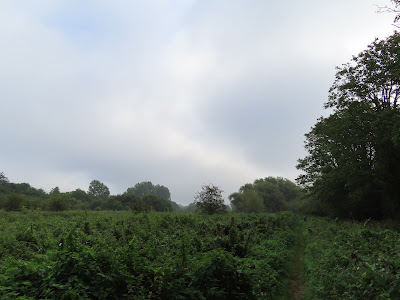




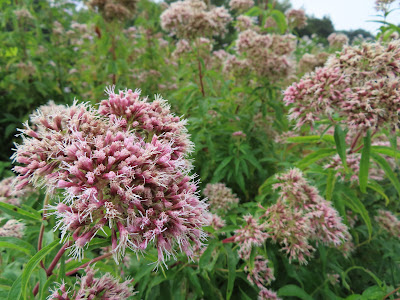















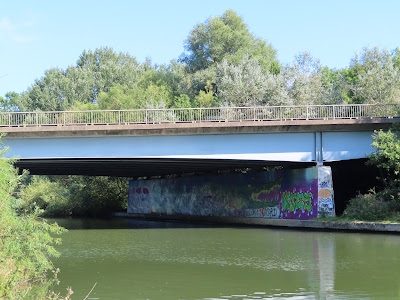
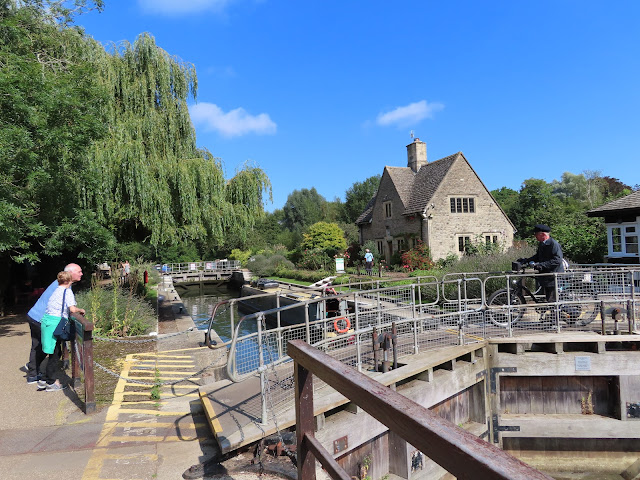


















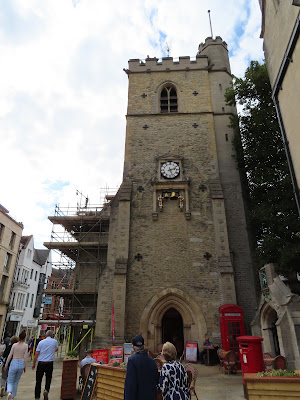

















No comments:
Post a Comment